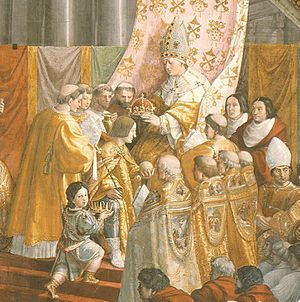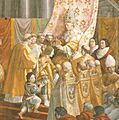Pope Leo III facts for kids
Quick facts for kids Pope Saint Leo III |
|
|---|---|
| Bishop of Rome | |

Mosaic at Triclinium Leoninum
|
|
| Church | Catholic Church |
| Papacy began | 27 December 795 |
| Papacy ended | 12 June 816 |
| Predecessor | Adrian I |
| Successor | Stephen IV |
| Personal details | |
| Born | 750 Rome, Exarchate of Ravenna, Eastern Roman Empire |
| Died | 12 June 816 (aged 65–66) Rome, Papal States |
| Previous post | Cardinal-Priest of Santa Susanna |
| Sainthood | |
| Feast day | 12 June |
| Venerated in | |
| Other Popes named Leo | |
Pope Leo III (who died on June 12, 816) was an important leader in the Catholic Church. He served as the Bishop of Rome and also ruled the Papal States from December 26, 795, until his death. He is famous for being protected by Charlemagne, a powerful Frankish king. Later, Pope Leo III made Charlemagne even stronger by crowning him emperor. This big event was not fully supported in Constantinople, the capital of the Byzantine Empire. However, the Byzantines were busy defending themselves and could not stop it.
Contents
Becoming Pope: Leo III's Early Life
Leo III was born in Rome around the year 750. His father was named Atzuppius, and his mother was Elizabeth. Many people believe he had a Greek background.
Before becoming pope, Leo was a cardinal-priest at a church called Santa Susanna. This was an important role in the Church. He also managed the pope's money and belongings as the vestiarius.
He was chosen as pope very quickly on December 26, 795. This was the same day the previous pope, Adrian I, was buried. He became pope officially the next day. This quick election might have been to prevent other groups, like the Franks, from getting involved.
To show his respect and ask for protection, Pope Leo III sent a letter to Charlemagne. He also sent the keys to St. Peter's tomb and the flag of Rome. Charlemagne was pleased and sent back gifts, including treasures he had won from battles.
Pope Leo III's Time as Leader
Charlemagne's gifts helped Pope Leo III give a lot of money to churches and charities in Rome. Charlemagne's letter to Leo was friendly. However, it also showed that Charlemagne believed both spiritual (Church) and worldly (government) powers should work together. He reminded the pope of his important spiritual duties.
An Attack on Pope Leo in 799
Some relatives of the previous pope, Adrian I, were jealous of Leo III. They thought only nobles should be pope. So, they planned to harm him.
On April 25, 799, while Pope Leo was in a procession, armed men suddenly attacked him. They threw him to the ground and tried to hurt his eyes and tongue. He was left injured and unconscious. Luckily, two of Charlemagne's officials, who had a strong force, rescued him.
Pope Leo III then went to Paderborn, where Charlemagne was staying. Charlemagne welcomed him with great honor. This meeting is even part of an old poem!
Charlemagne ordered the attackers to come to Paderborn, but no decision was made there. So, he sent Leo back to Rome. In November 800, Charlemagne himself came to Rome. On December 1, he held a meeting with both sides. On December 23, Pope Leo III swore an oath that he was innocent of the charges against him. His attackers were then sent away from Rome.
Crowning Charlemagne as Emperor

Charlemagne's father, Pepin the Short, had protected the pope from invaders. He also gave land around Rome to the pope. This land became the Papal States.
Two days after Pope Leo III swore his oath, on Christmas Day in 800, a very important event happened. Pope Leo III crowned Charlemagne as emperor. Charlemagne's helper, Einhard, said that Charlemagne did not expect this and would not have accepted the crown if he had known.
However, it is likely that people had been talking about making Charlemagne emperor for a while. At that time, the emperor's throne in Constantinople was held by a woman, Irene of Athens. This was unusual and caused some debate. Also, Charlemagne's family had become very powerful.
This crowning upset the people in Constantinople. They believed they were still the rightful protectors of Rome. But Empress Irene was not strong enough to offer much help to the city.
In 808, Pope Leo III asked Charlemagne to protect the island of Corsica. Muslim raiders from Spain were attacking the island. Even with this help, Muslim forces occupied Corsica and Sardinia in 809 and 810.
Church Leadership and Beliefs
Pope Leo III helped bring back King Eardwulf of Northumbria to his throne. He also helped settle disagreements between church leaders in England. He changed a decision made by the previous pope about a church leader in Lichfield, England. Leo believed the information given to the previous pope was wrong. So, in 803, Lichfield became a regular church area again.
Pope Leo III strongly supported the belief that the Holy Spirit proceeds from both the Father and the Son. He said it was wrong not to believe this important part of faith. However, he refused to change the main Christian creed, the Nicene Creed. He believed the creed was perfect and created by God's guidance. He also thought that not everything needed for salvation had to be in the creed.
To show his strong belief, Leo III placed two silver shields in Rome. These shields had the original creed written on them in both Greek and Latin. He put them at the entrance of St. Peter's Basilica. This was to show his love for and to protect the true Christian faith.
Death and What He Left Behind
Pope Leo III died in 816 after being pope for more than 20 years. He was first buried in his own special tomb. Later, his remains were moved to a tomb that held the first four popes named Leo. In the 1700s, the remains of Leo the Great were moved to his own chapel.
Pope Leo III was recognized as a saint by Pope Clement X in 1673. His name was then added to the official list of saints.
See also
 In Spanish: León III (papa) para niños
In Spanish: León III (papa) para niños
- List of Catholic saints
- List of popes
- Donation of Constantine
Images for kids



